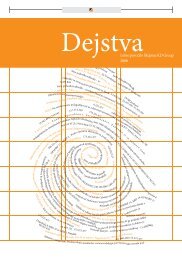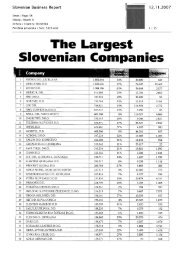The Group KD Group and KD Group dd
The Group KD Group and KD Group dd
The Group KD Group and KD Group dd
Create successful ePaper yourself
Turn your PDF publications into a flip-book with our unique Google optimized e-Paper software.
<strong>The</strong> <strong>Group</strong> <strong>KD</strong> <strong>Group</strong> Annual Report 2009<br />
Notes to Consolidated Financial Statements as at <strong>and</strong> for the year ended 31 December 2009<br />
For the purposes of a collective evaluation of impairment, financial assets are grouped on the basis of similar credit risk<br />
characteristics (using the valuation model of the <strong>Group</strong>, which takes into account the type of assets, industry, geographical<br />
location, type of investment, maturity <strong>and</strong> other relevant characteristics).<br />
Those characteristics are relevant to the estimation of future cash flows for groups of such assets by being indicative of the<br />
debtors’ ability to pay all amounts due according to the contractual terms of the assets being evaluated.<br />
Future cash flows in a group of financial assets that are collectively assessed for impairment are estimated on the basis of the<br />
contractual cash flows of the assets in the <strong>Group</strong> <strong>and</strong> historical loss experience, namely on the basis of similar credit risk<br />
exposure in the past. Historical loss experience is restated on the basis of current observable data to reflect the effects of<br />
current conditions that did not affect the period on which the historical loss experience is based <strong>and</strong> to remove the effects of<br />
conditions in the historical period that do not exist currently.<br />
Estimates of changes in future cash flows for groups of assets should reflect <strong>and</strong> be directly consistent with changes in<br />
related observable data from period to period (for example, changes in unemployment rates, property prices, payment status,<br />
or other factors indicative of changes in the probability of losses in the group <strong>and</strong> directly consistent with their magnitude). <strong>The</strong><br />
methodology <strong>and</strong> assumptions used for estimating future cash flows are reviewed regularly by the <strong>Group</strong> to reduce any<br />
differences between loss estimates <strong>and</strong> the actual loss .<br />
If, in a subsequent period, the amount of the impairment loss decreases <strong>and</strong> the decrease can be related objectively to an<br />
event occurring after the impairment was recognised (such as an improvement in the debtor’s credit rating), the previously<br />
recognised impairment loss is reversed by adjusting the allowance account. <strong>The</strong> amount of the reversal is recognised in the<br />
income statement.<br />
When an asset is uncollectible, it is written off against the allowance account for the asset. Such assets are written off after all<br />
the necessary procedures have been completed <strong>and</strong> the amount of the loss has been determined. Subsequent recoveries of<br />
amounts previously written off decrease the amount of the impairment charge in the income statement.<br />
(b) Financial assets classified as available for sale<br />
<strong>The</strong> <strong>Group</strong> assesses at each balance sheet date whether there is objective evidence that a financial asset or a group of<br />
financial assets is impaired. In the case of equity investments classified as available for sale, a significant or prolonged<br />
decline in the fair value below their cost, a maximum period of 9 months from the date when the fair value of equity<br />
instruments first fell below the purchase price <strong>and</strong> has remained below the total period of 9 months is taken into account,<br />
while in determination of a significant decrease in the assessment of fair value, the management takes into account at least<br />
40% reduction in the fair value.<br />
If any such evidence exists, the cumulative loss – measured as the difference between the acquisition cost <strong>and</strong> the current<br />
fair value, less any impairment loss on the financial asset previously recognised in profit or loss – is removed from equity <strong>and</strong><br />
recognised in the income statement. If, in a subsequent period, the fair value of a debt instrument classified as available for<br />
sale increases <strong>and</strong> the increase can be objectively related to an event occurring after the impairment loss was recognised in<br />
profit or loss, the impairment loss is reversed through the income statement.<br />
2.9.2 Impairment of non-financial assets<br />
Intangible assets which are not subject to amortisation are tested annually for impairment. Assets that are subject to<br />
amortisation are reviewed for impairment whenever events or changes in circumstances indicate that the carrying amount<br />
may not be recoverable. An impairment loss is recognised for the amount by which the asset’s carrying amount exceeds its<br />
recoverable amount. <strong>The</strong> recoverable amount is determined for an individual asset, unless the asset does not generate cash<br />
inflows that are largely independent of those from other assets or groups of assets. In such case, the recoverable amount is<br />
established for a cash-generating unit i.e. the smallest identifiable group of assets that generates cash inflows that are largely<br />
independent of the cash inflows from other assets or groups of assets. <strong>The</strong> criterion for determining the cash-generating units<br />
is the individual business area of the <strong>Group</strong>. <strong>The</strong> recoverable amount of an asset or a cash-generating unit is the higher of its<br />
fair value less costs to sell <strong>and</strong> its value in use.<br />
2.10 Inventories<br />
Inventories are stated at the lower of cost <strong>and</strong> net realisable value. Cost is determined using the weighted average cost<br />
method. Net realisable value is the estimated selling price in the ordinary course of business, less applicable variable selling<br />
expenses.<br />
95







